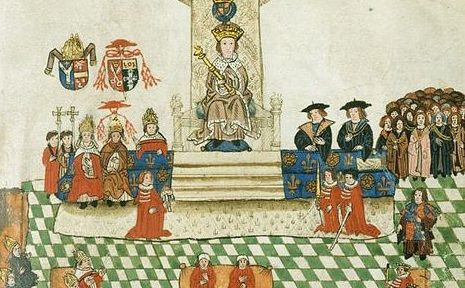
This was a big day, the point of no return in Henry’s work to set aside Catherine of Aragon. Up until now, nothing was totally irrevocable. Today’s move created the line that got people (including Sir Thomas More) martyred.
The sequence was a careful one: on March 30, 1533, Thomas Cranmer was consecrated as Archbishop of Canterbury, the top religious post in England – with bulls from the Pope which gave him religious authority stemming from the unbroken succession of Catholic bishops back to the apostles (read my blog post explaining it in more detail here). In April 1533, Parliament passed the Act in Restraint of Appeals forbidding appeals to the Pope on religious matters…which opened up the next step: on May 23, 1533, Cranmer formally declared Henry’s marriage to Catherine of Aragon invalid. Since no appeals were permitted, the verdict was final and Anne Boleyn was crowned Queen of England on June 1.
Of course the Pope was furious and reacted by provisionally excommunicating Henry…but even full excommunications could be reversed (in medieval times excommunication was the way popes flexed their muscles). Henry may well have stopped here if Anne Boleyn had birthed a son instead of a daughter. He might have felt vindicated that God had agreed with him – the whole country would have accepted the boy as the proper heir to the throne. But because Elizabeth was a girl, the issue was not as clear-cut. The people were not enthusiastic about setting aside Mary (whom they loved) for another girl, especially a newborn (a significant percentage of children back then died before their sixth birthdays…). To force the issue, the First Act of Succession was passed on March 23, 1534 establishing Elizabeth as the heir to the throne. Since Parliament had the right to determine the succession, that could have settled matters …but that wasn’t good enough for Henry.
Maybe it wasn’t good enough because even then Henry’s ego was enormous. Maybe it was because Cromwell was tempting him with the enormous wealth of the English monasteries (Henry had frittered away the fortune his father had so carefully amassed and was thrilled at the opportunity to refill his coffers). Either way, today’s Supremacy Act established Henry as Supreme Head of the Church in England – and it was followed by the Treasons Act which made it full blown treason to deprive the King of “his dignity, title, or name.” It was no longer enough to bend the knee to Elizabeth: Englishmen now had to deny the Pope. This was the ultimate line – and the executions did not tarry long afterwards…
***
If you like my posts, you’ll love my books! My Seymour Saga trilogy tells the gripping story of the short-lived dynasty that shaped the Tudor Era. Jane the Quene skews romantic, The Path to Somerset is pure Game of Thrones (without the dragons), and The Boy King is a noir coming-of-age. Get them now through Amazon, Barnes & Noble, Kobo, and Apple, or even your local independent bookstore!

(PS Already read them? Did you love them? Then please review them – even just a stars rating! It makes a huge difference in helping new readers find them and would mean the world to me!)

Be First to Comment